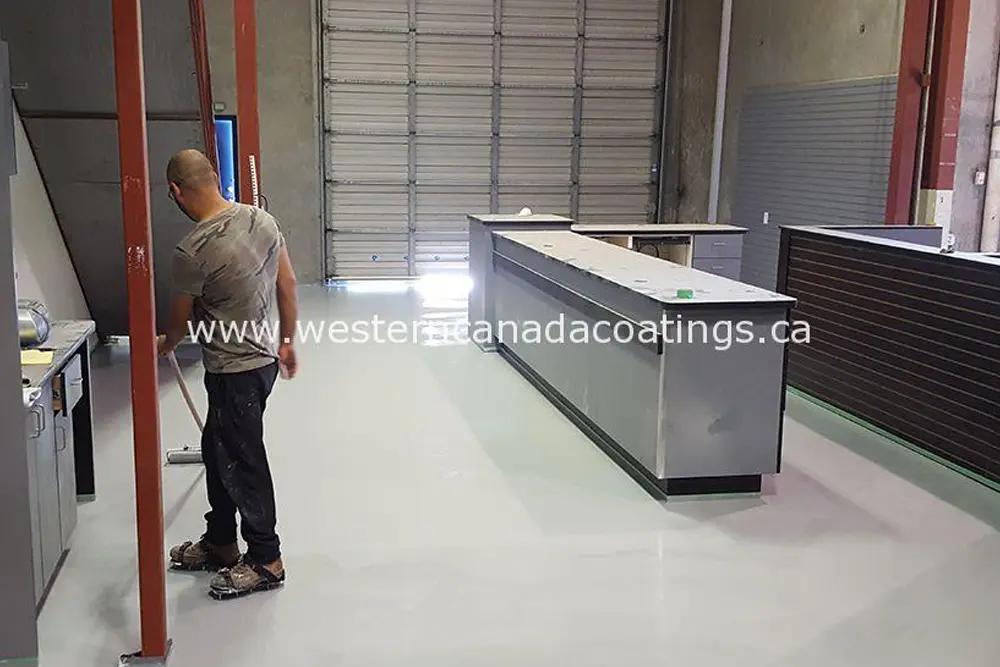Surface preparation in epoxy flooring is probably the most important factor when executing an industrial flooring project. Unfortunately, it is usually the most overlooked factor. Too many flooring projects are failing, because the surface preparation was inadequate. Manufacturers of epoxy paints have been claiming lately to have a product so good, there is no need to grind or prime the surface first. These claims can be very misleading, especially when large industrial projects are at stake.
Surface Preparation in Epoxy Flooring
So what constitutes proper surface preparation? Which method is the best? This is a good question as depending on the application in question you may need to approach the problem in a different manner. I have identified several levels of surface preparation according to their mechanical intensity. Some methods (like sanding) are light and barely scratch the surface. Other methods (like scarifying) can be deep and intense.
Sanding
Sanding is the lightest form of surface Prep, usually done with an angle grinder or a light floor sander. Such surface prep is only appropriate for re-coat jobs, or if you are just applying for a light paint job. Even if you use rough, low grit sandpaper, the surface scratch will be fine.
Read More About Epoxy Floor Thickness
Stone Grinding
Stone grinding machines were the tool of choice before the invention of diamond grinders. This is essentially a heavy floor grinder that has stone tools fastened to the bottom. This works well for a soft concrete surface but it does not grind well on hard concrete or epoxy.
Surface Preparation in Epoxy Flooring is crucial. As a rule of thumb, you should expect it to take up at least 40-50% of the necessary man-hours in a project. Clients often put pressure on the contractor to hurry up with the surface prep. They usually complain about the dust, the noise, or simply that it’s taking too much time.
Poor surface preparation can lead to huge post-project problems. Problems may include the coating cracking, or detaching itself from the substrate. Other problems may include bubbles or other particles in the coating, wrecking the appearance of the floor. The worst part is that the problems may not appear straight away, but after a few months when the industrial facility is in full operation. The costs for repairing the floor could be massive if operations need to be stopped.
Read More About Benefit of Epoxy Flooring
Diamond Grinders
Diamond Grinders allow easy switching out of diamonds, and can therefore handle all types of floors from soft cement to hard concrete. They can also strip old paint layers and clean out oily patches of the floor.
Diamond grinding leaves a much deeper and harsher scratch profile of the floor (compared to sanding) and this, therefore, enables better bonding of the primer to the floor. I also find if you are dealing with messy and contaminated patches, a bit of persistent diamond grinding is enough to give you a nice clean floor. This is my preferred choice if I’m working with standard floor systems up to 2-3mm. Watch this video to understand how a diamond grinder works
Shot-blasting
Shot-blasting is a more aggressive method of surface preparation than grinding. It leaves a nice deep profile that makes the bonding conditions for high build flooring systems (3mm and over) ideal. However, shot blasting requires very good high-quality concrete to work properly. If you try shot-blasting a weak substrate you could very well end up damaging the substrate.
Scarifying
I’ve put scarifying last because I consider it a last resort option, as this is a very aggressive form of surface preparation that digs into the surface. When faced with horrible looking and contaminated floors, however, I’ve turned to a scarifier and was able to clean the surface and apply a new thick heavy build coat
Conclusion
Clients will often put pressure on the contractor to hurry up with the surface prep or be aggravated by the dust and noise it produces. Surface preparation in epoxy flooring is crucial, however; and as a rule of thumb, you should expect it to require at least 40-50% of the necessary man-hours in a project. This is because poor surface preparation can lead to huge post-project problems.
These problems may include the coating of the floor cracking or detaching itself from the substrate. Other problems may include bubbles or other particles in the coating, wrecking the appearance of the floor. It is important to note that these problems may not appear right away, but after a few months, when the facility is in full operation. This could lead to massive losses if operations need to be stopped, simply because the floor was not prepped right.

